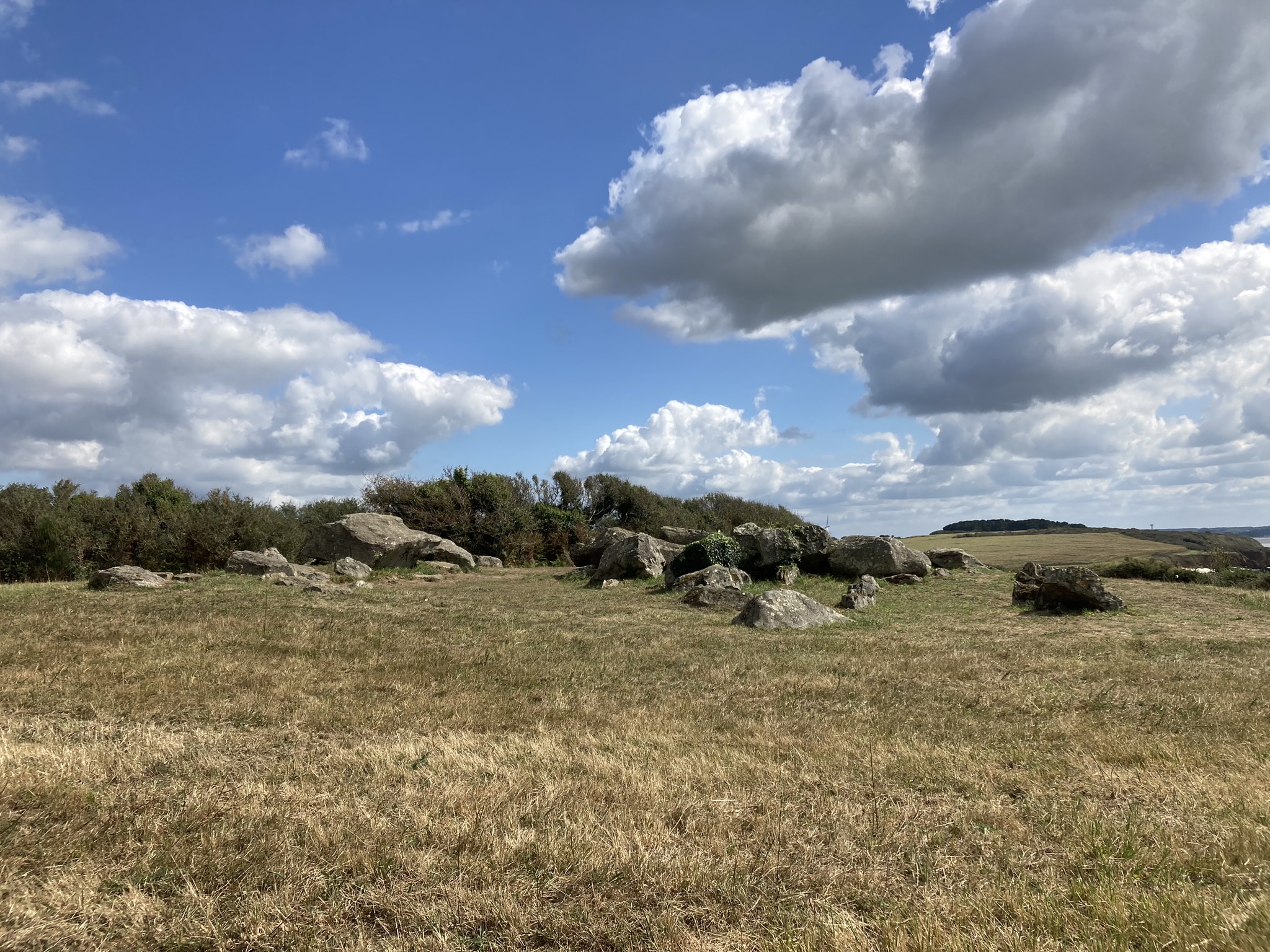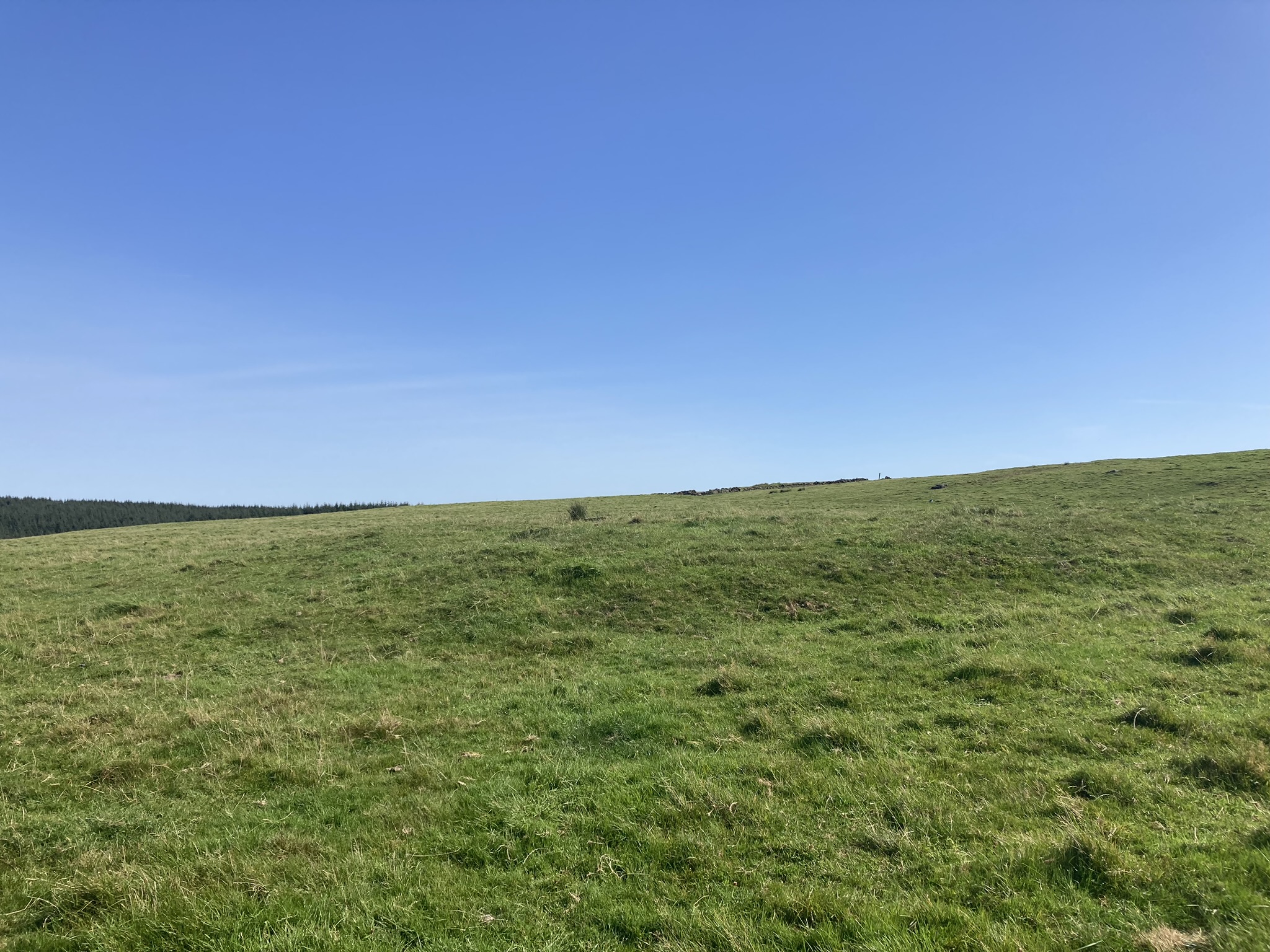
Allee Couverte de Grah-Niol viewed from N. (15.09.23)

Allee Couverte de Grah-Niol viewed from N. (15.09.23)

Allee Couverte de Grah-Niol viewed from E. (15.09.23)

Allee Couverte de Grah-Niol viewed from E. (15.09.23)

Standing Stone of Allee Couverte de Grah-Niol viewed from N. (15.09.23)
Visited 15.09.23
Allee Couverte de Grah-Niol is located on a narrow lane on the Northern edge of Arzon. There is convenient parking 50m N of the site. There is a low fence round the allee-couverte denying any internal access. This is unfortunate as there are carved stones inside the passage of the monument. A standing stone is erected on the E end of Allee Couverte de Grah-Niol, on the roadside.

Cairn de Petit Mont viewed from North-East. (15.09.23)

Blocked Entrance of Chamber 3a (East) of Cairn de Petit Mont.(15.09.23)

Passage of Chamber 3b (North-East) of Cairn de Petit Mont.(15.09.23)

Carved Stone in Chamber 3b (North-East) of Cairn de Petit Mont.(15.09.23)

Passage of Chamber 2 (East) of Cairn de Petit Mont.(15.09.23)

Chamber 2 (West) of Cairn de Petit Mont.(15.09.23)
Visited 15.09.23
It is only 6 euros to access the Cairn de Petit Mont. Given the size of the site that is good value. It includes a group tour in French of the Cairn & Dolmen 3b, which is off limits without a tour guide. I requested some English commentary and the guide was obliging enough to give me a short lecture in English. I was also able to take photos in Chamber 3b.
Directions to Cairn de Petit Mont: Take the signed turn from the central roundabout in Arzon onto Rue de Lenn Vihan. Follow this road for c. 1.4 km to reach a car park for Cairn de Petit Mont. A path starts in the SW corner of the car park. Follow this path SW for 240m. Turn left and walk 50m to the entrance of the Cairn de Petit Mont.
Visited 15.09.23
Cairn de Petit Mont is a large pentagonal cairn perched on a headland South-West of Arzon in Morbihan. The elevated position has extensive sea views and enables the cairn to be seen from afar. The unusual shape of the cairn, which currently measures 55m long by 55m wide, may be a result of its multi-phase construction. According to the tour booklet, a mound covering a closed chamber (Chamber 1) was constructed in c. 4600 BC. The mound measured 50m x 19m x 1.6m. A stone cairn, measuring 22m long and 12m wide was erected over the mound c. 100 years later. 700 years later a chambered cairn with one accessible chamber (Chamber 2) was built over the original cairn. After another 1100 years a fourth phase of building occurred in 2700 BC. The cairn was modified and extended. Chamber 2 was blocked off and Chamber 3a and 3b were built, accessed by passages from the East side of the new cairn.
Unfortunately, this was not the final modification of Cairn de Petit Mont. Due to its strategic position on the coast Hitler order the construction of a concrete bunker within the cairn in 1943. The bunker was built in the S side of the cairn. This modification completely destroyed Chamber 3b and partially destroyed the passages of Chamber 2 and Chamber 3a. The cairn was neglected until 1979 when archaeological excavations resulted in the final phase of modifications, completed in 1989. As a result Chamber 3a and its passage were restored. We also have access to Chamber 2 via the Bunker. The facades of the cairn were modified into a series of 3 steps with a flat roof.

Tumulus de Tumiac viewed from SW. (15.09.23)
Visited 15.09.23
I stumbled across Tumulus de Tumiac while waiting for the Petit Mont Cairn to open; Mad dogs and Scotsmen go out in the midday sun. I saw the mound on the horizon and experienced the usual gravitational attraction. A path to Tumulus de Tumiac is conveniently located in a lay-by on the E edge of Arzon in a long straight on the D780. The site is closed to the public, a relatively common state of affairs in my experience, so I contented myself with a distant view. The grassy mound measures 86m in diameter and 20m high according to the information board. A central tomb, measuring 4.4m x 2.4m x 1.75m, is covered by successive layers of clay. The mound has been dated to 4790 BC.
The mound is known locally as Butte de Cesar (Caesar’s Mound). He is reputed to have witnessed a naval battle from the summit of Tumulus de Tumiac in 56 BC.


Passage of Cairn de Gavrinis viewed from SW. (15.09.23)

Carved Stone in Passage of Cairn de Gavrinis viewed from SW. (15.09.23)

Chamber of Cairn de Gavrinis viewed from SW. (15.09.23)

Carved Stone in Chamber of Cairn de Gavrinis viewed from SE. (15.09.23)

Recesses in Carved Stone in Chamber of Cairn de Gavrinis viewed from SE. (15.09.23)
Visited 15.09.23
I travelled to the Cairn de Gavrinis via a pre-booked trip from Port-Navalo with Le Passeur des Iles on a 20 person boat. The journey to the island took around 20 minutes. There was an organised lecture on the Cairn de Gavrinis in French for around 30 minutes before we were allowed to enter the passage in small groups. We were allowed free access to the passage and chamber, which are lit by subdued lighting, for 5 minutes. There were no restrictions on photography allowing me to take some good pictures of the carved stones in the passage and the chamber. The boat was waiting at the end of the tour. I would recommend this trip though I could have done without the extended lecture in French.
Visited 14.09.23
Access to this monument has been restricted by a low fence round the perimeter. There is an official sign denying permission to enter the dolmen. I respected this request reluctantly because I would have liked to see the carved stones in the monument.
Visited 14.09.23
Mané-er-Hroëck tumulus is easily visited via a signed footpath off Rue de Kerpenhir. The chamber entrance is obviously modern but that doesn’t detract from the atmosphere in the plain chamber in the centre of the tumulus.

NNW Face of Menhir de Kerpenhir. (14.09.23)

SSE Face of Menhir de Kerpenhir. (14.09.23)

WSW Face of Menhir de Kerpenhir. (14.09.23)
Visited 14.09.23
Menhir de Kerpenhir is a massive irregular standing stone on the coast c. 200m N of Société Nautique de Locmariaquer (Locmariaquer Sailing Club). The menhir is c. 3.5m high by 2.5m wide. It is orientated ENE-WSW on its broad faces.
Menhir de Kerpenhir is featured on page 160 of Le guide des mégalithes du Morbihan by Gabriel Le Cam. This book is an indispensible photographic record of 338 monuments in the Morbihan area.
There is a large car park off Route de Kerpenhir on Pointe de Kerpenhir, c. 2km SSE of Locmariaquer. Walk c. 40m N from the Car Park to reach a closed gate on the right. Follow a track W round the coast. After c. 350m turn left along a path. Follow this path W for c. 100m to reach Menhir de Kerpenhir.
Visited 14.09.23
Grand Menhir Brise is one of Locmariaquer’s big three sites. It is only accessible via the Site des Megalithes Visitor Centre for 6 euros. To be fair, there are three impressive monuments, unrestricted visiting time and free parking so what’s not to like?
Grand Menhir Brise consists of four massive recumbent stones which are though to have been parts of one of the largest ever menhirs, measuring c. 20 metres long. There is speculation as to whether the Grand Menhir Brise either broke on erection or as a result of an earthquake or was deliberately toppled. There is archaeological evidence of 19 socket holes forming a giant stone row, with Grand Menhir Brise as an end stone. Whatever the reality, there is no doubt that the Grand Menhir Brise is an impressive antiquity.
Visited 14.09.23
Table des Merchants is one of Locmariaquer’s big three sites. It is only accessible via the Site des Megalithes Visitor Centre for 6 euros. To be fair, there are three impressive monuments, unrestricted visiting time and free parking so what’s not to like?
La Table des Merchants is a cairn constructed in 1993 around the surviving naked dolmen for the preservation of the antiquity. It was interesting to see the carved rear stone and ceiling in the chamber. However, the new cairn reminds me of the reconstructed cairn at Newgrange. I prefer my ancient monuments unadulterated.
Visited 14.09.23
Er-Grah Tumulus is one of Locmariaquer’s big three sites. It is only accessible via the Site des Megalithes Visitor Centre for 6 euros. To be fair, there are three impressive monuments, unrestricted visiting time and free parking so what’s not to like?
Er-Grah Tumulus has gravitas but it’s long thin footprint make it difficult to capture a definitive image. The undoubted focus is the central tomb with its massive capstone, the cherry on the cake. I decided to walk slowly round Er-Grah Tumulus absorbing its antiquity as I strolled.
Visited 14.09.23
I followed directions to Dolmen de Mané Rutuel from the Tourist Office in Locmariaquer. After a 5 minute walk, I discovered that the long mound is closed to the public due to safety concerns. I was reduced to walking round a protective fence, making the best of limited views. Mané Rutuel is an impressive monument but a disappointing outcome.

Menhir er Bronzo viewed from NE. (14.09.23)

Menhir er Bronzo viewed from SW. (14.09.23)

Menhir er Bronzo viewed from NW. (14.09.23)
Visited 14.09.23
I found the Menhir du Bronzo by following the Sites des Megalithes sign opposite the Tourist Office. The broken menhir is located in a vacant plot on the left of Ruelle du Bronzo. The site has two large stones: the erect bottom half in the SW and the displaced top half lying to the NE. Each half of the broken stone measures c. 6 feet long.

Dolmens Des Grays viewed from E. (13.09.23)

Dolmens Des Grays viewed from S. (13.09.23)

Dolmens Des Grays viewed from W. (13.09.23)

Dolmen A (N) of Dolmens Des Grays viewed from NE. (13.09.23)

Dolmen B (SW) of Dolmens Des Grays viewed from S. (13.09.23)

Dolmen C (SE) of Dolmens Des Grays viewed from S. (13.09.23)
Visited 13.09.23
Dolmens des Grays is located 5 minutes E along the coastal path starting in Pen Lan Car Park. At first sight the monument is a jumble of stones. There is an interpretation board, suggesting that the cairn consists of an amalgam of 3 separate tombs. It divides the cairn into Tomb A,B & C. They are in the N, SW & SE respectively.
Continue E along the path for 10 minutes to reach Dolmen du Crapaud.
Visited 13.09.23
Dolmen du Crapaud is located on a cliff edge SE of Plage des Granges, S of Pen Lan (Penn Lann). The remains of this site have been much reduced by coastal erosion. The chamber resembles a toad viewed from N, hence the french name Dolmen du Crapaud.
The site is easily accessible from a coastal path starting in Pen Lan Car Park, heading E past Cairn des Grays to Les Granges.




